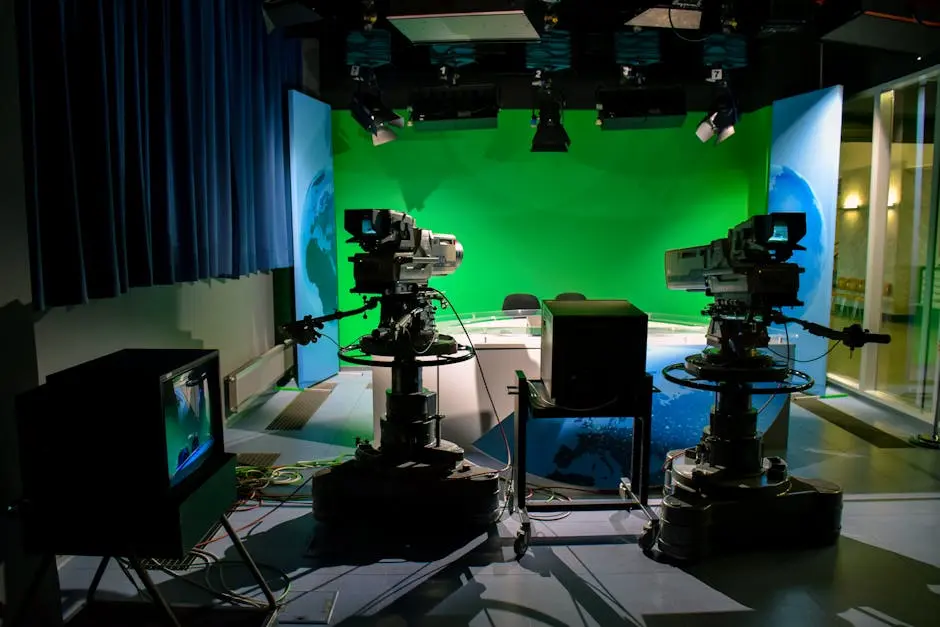Television broadcasting continues to evolve with innovative techniques that make broadcasts more engaging and captivating for viewers. As technology advances, so do the possibilities for TV studios to create unique content. In this listicle, we’ll explore some groundbreaking techniques that are redefining the landscape of TV broadcasts.
1. Immersive Virtual Sets
Virtual sets are revolutionizing the way TV studios present their shows. By using green screens and realistic graphics, shows can transport viewers anywhere in the world, or even to fantasy realms. This technique is not only cost-effective but also opens up an endless array of creative possibilities. Imagine a news broadcast directly from the heart of a bustling Times Square without moving an inch. Producers can seamlessly shift between stunning backdrops to enhance storytelling and captivate the audience.
Moreover, the versatility of virtual sets allows for unprecedented levels of customization. Directors can alter elements within the scene on the fly, adjusting lighting and props at the push of a button. This adaptability ensures high production quality while reducing the constraints of physical set designs. Transitioning from location to location within the narrative becomes a fluid process, allowing for a more dynamic and compelling viewing experience.
2. Interactive Audience Engagement
Engaging the audience directly has never been easier with live polls, social media integration, and real-time feedback during broadcasts. This interaction not only helps tailor content to the audience’s preferences but also creates a more engaging viewing experience. The integration of social media platforms into live broadcasts allows for an interactive dialogue with viewers.
Shows that incorporate audience input can develop a loyal following as viewers feel a sense of ownership and connection to the content. Imagine the excitement of seeing your own tweet appear live on a national broadcast. This level of interaction not only retains viewers but also encourages them to share their experiences, expanding the reach of the broadcast.
Moreover, real-time feedback can guide a broadcast’s direction by highlighting popular segments or areas for improvement. When audiences actively participate, they are more invested in the outcome, leading to a richer, more collaborative viewing experience. Television becomes more than just a passive activity; it transforms into an interactive community event.
3. Advanced Camera Robotics
Robotic cameras provide precision and flexibility in capturing dynamic shots that were previously difficult to attain. With programmable movements and seamless transitions, they enable directors to focus on creativity and storytelling. The ability to execute complex camera movements without the constraints of physical human operation opens doors to visually stunning sequences.
Gone are the days of static camera shots, where creativity was limited by human capacity. Now, TV studios can achieve cinematic camera work that enriches narrative depth. For example, a swooping aerial view transitioning into a close-up can be flawlessly executed, adding a level of professionalism typically reserved for high-budget films. These advancements not only streamline production but also reduce the risk of human errors during recording.
Furthermore, the implementation of robotic systems can lead to cost savings over time, reducing the need for extensive camera crews while still delivering high-quality footage. Studios can focus resources on other areas, such as set design or special effects, enhancing the overall quality of the production.
4. High Dynamic Range Imaging
HDR imaging enhances the visual quality of broadcasts by providing a more vibrant and realistic color palette. It allows viewers to see details in both the brightest and darkest parts of a scene, making the content more visually appealing. The depth and clarity brought by HDR technology create an immersive viewing experience, akin to what audiences expect in high-end movie theaters.
This advancement is particularly beneficial in nature documentaries or sports broadcasts where vivid details and color realism play a crucial role in viewer engagement. Imagine watching a spectacular sunset or an intense NBA game with every hue and shadow richly detailed. HDR technology elevates ordinary scenes to breathtaking visual spectacles, sparking joy and excitement at every frame.
5. Augmented Reality Overlays
Augmented reality adds a new dimension to TV shows by overlaying information and graphics onto the screen. This can be used for anything from sports statistics to interactive news segments, offering an enriched viewing experience. For instance, during a football match, real-time player stats and heat maps can be displayed.
The ability to enhance storytelling with graphic overlays can lead to a more informed and engaged audience. News broadcasts can incorporate live data feeds directly into the screen, providing context and clarity to complex issues in real-time. Viewers are not just passive recipients; they become active participants in the narrative, able to digest information that is contextualized visually alongside the spoken word.
Moreover, educational programs leverages AR to visualize complex data, turning abstract concepts into accessible knowledge. This approach not only appeals to visual learners but also enhances retention and comprehension. As a tool, AR transforms the passive act of watching into an interactive educational journey, paving the way for more impactful broadcasts across diverse genres.
6. Automated Content Recognition
Using ACR technology, TV studios can automatically identify and tag content, making it easier to distribute and monetize. This is especially useful for archiving and searching through large volumes of footage. ACR simplifies the management of content libraries by streamlining the process of metadata entry, saving time and reducing errors.
Imagine a vast archive of shows and clips that are readily accessible, categorized, and searchable by numerous criteria, such as theme, date, or participant. This not only aids in content retrieval but also opens new avenues for content repurposing. Studios can monetize extensive archives by offering specific clips to online platforms or reselling edited packages, breathing new life into existing footage.
7. Cloud-Based Production
Cloud technology enables TV studios to store, edit, and collaborate on content remotely. This increases flexibility, reduces costs, and allows for content to be produced and aired faster than ever before. Teams scattered across various locations can work on producing content simultaneously, breaking the limitations of physical boundaries.
Production teams can now collaborate in real-time, utilizing high-speed cloud storage solutions to share edits and feedback instantly. This not only expedites timelines but also facilitates international collaborations, bringing diverse viewpoints into a single cohesive production. The agility provided by cloud-based production tools results in more timely and relevant content, resonating deeply with a global audience.
8. 3D Audio Technology
Adding another layer of immersion, 3D audio technology creates a surround sound experience for the audience, enhancing storytelling by enveloping the viewer in the soundscape of the broadcast. Imagine feeling the roar of a crowd from multiple directions during a live sports event or being surrounded by the hustle and bustle of a lively city scene in a dramatic series.
This auditory experience makes broadcasts more captivating by aligning sound directionality with visual cues, providing a richer sensory experience. The precise placement of sound can draw viewers deeper into scenes, whether it be a whispering wind or a thunderous explosion, all contributing to the realism and impact of the broadcast. By mastering the use of sound, TV studios can elevate the emotional and narrative depth of their programming, drawing audiences closer to the action and enhancing the overall viewing experience.


